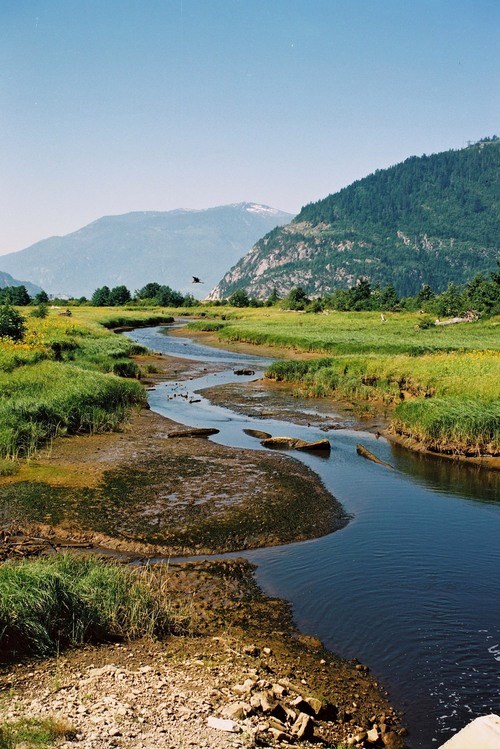The 1.1 km Woodpecker Trail will give you an exciting walk over gently rolling terrain and through second-growth aspens, big leaf maples, and spruce trees.
The eastern portion of the trail is east-going towards and along Crescent slough on a well-trod single track. In springtime, there are a plethora of wildflowers that will enhance your outing.
The edges are subject to erosion and flooding during higher high tides and freshets so the trail may be impassable. This is nature at work, and us mere mortals must wait for the water to return to normal levels.
The western portion of the trail is off the west side of Spit Road and along the river edge for 300 metres.
This section tends to suffer from quick overgrowth. Both sections provide fine birding opportunities.
The wood duck nesting boxes along the trail should not be closely inspected nor disturbed in any way.
This area is in the Skwelwil’em Squamish Estuary Wildlife Management Area, which is administered by the provincial Ministry of Environment through the Squamish Estuary Management Committee. The WMA is in place to protect and preserve wildlife, fish and their habitat; not to provide recreational opportunities.
The basic premise is that no commercial, industrial nor residential activity is allowed west of the railway tracks. These dictates have been included in the Official Community Plan (OCP). There are signs at the entrances to the WMA that specify the rules for protecting wildlife and the most noteworthy is the mandatory requirement for dogs to be on a leash.
Chasing birds and destroying nesting sites could eventually result in dogs being completely banned from the WMA, for much the same reason that Garibaldi Provincial Park is now closed to dogs.
Bird watchers delight in the many sightings of members of the Picade family of birds. Woodpeckers have strong beaks for drilling into trees and long sticky tongues for extracting the boring insects. Their skulls have evolved to absorb the shock of hammering into solid wood. The myth that woodpeckers kill trees is easily debunked. They keep trees healthy by eating the wood-boring insects that would deal a death blow to the tree if left unchecked. Those dead trees that you see woodpeckers hammering away on were already compromised by insect infestation, which will kill the tree no matter what the woodpeckers do.
Local woodpeckers range in size from the small 14 cm downy to the large crow-sized pileated, which is North America’s largest and most conspicuous with its red top knot.
Flicker, hairy and red-breasted sapsucker are the other common woodpeckers in our area.
Important Birding Area’s (IBA) are discrete sites that support migrating and nesting birds. These areas are especially important for preserving feeding zones along migration flyways and are governed by the Canada - U.S. Migratory Bird Convention of 1916.
Our local IBA is BC023 and covers 49 km from the estuary northwards including the shoreline of the Squamish, Mamquam and Cheakamus rivers. People need to be cautious because of the dwindling supply of safe areas for rearing fledglings.
Spit road will likely be partially blocked for construction of new water flow inlets into the estuary during the 2018 construction season. Traffic may be slowed, but access should remain open.
Quick facts:
Origin of name:
Various types of woodpeckers are seen on this trail.
Trailhead:
Off the upper part of Spit Road.
Use:
Hiking and birding.
Difficulty:
Green.
Elevation:
6 to 10 metres.
Etiquette;
Do not disturb wildlife.



